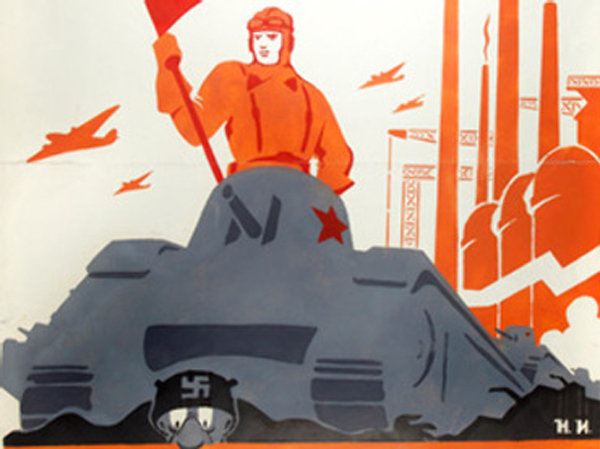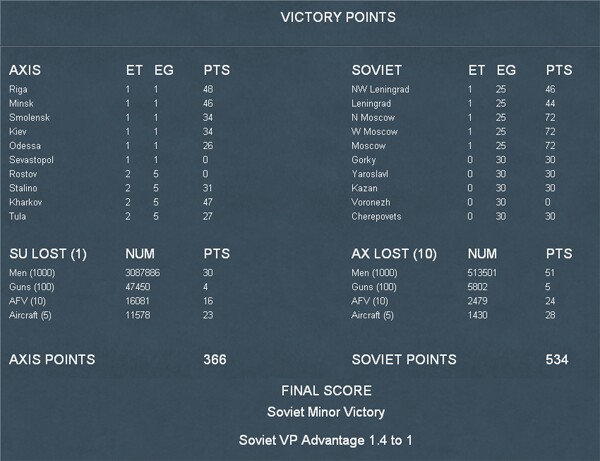 534:366 = Soviet Minor Victory
534:366 = Soviet Minor Victory
Uh-oh.

Let’s take a look at how I did compared to the historical result:
Army Group South: I captured Kiev in August without the diversion of panzer forces from Army Group Center, which is more than can be said for Field Marshal von Rundstedt, who took it in September with assistance from Guderian’s panzers. Also, Odessa (one of the victory point cities) fell in September, whereas historically the Rumanian Army captured it in October. Kharkov fell to the Germans (the first time) in late October 1941. I took the city in late September. In the actual campaign, the Germans captured Rostov in November, but relinquished it a week later. I never reached it. Sevastopol had to wait until 1942 for von Manstein to capture it, and I didn’t get close, either. Let’s say the actual Germans got a week of victory points out of Rostov, which I didn’t. I got an extra month out of Kiev, Odessa, and Kharkov. But I didn’t get to the “gateway to the Caucasus.” I was going to call this a wash, but if you want to give the nod to von Rundstedt for his erstwhile capture of Rostov, be my guest.
Army Group Center: The big prize, Moscow, never fell to the Germans, digital or otherwise. However, if you look at victory point cities, I captured both Tula and Voronezh, neither of which fell to the Germans in 1941 in real life. Also, my forces got much closer to Moscow than the real Germans did, advancing to within ten miles (one hex) of the city in several places with substantial panzer forces. Two of the three Moscow hexes were attacked by nearly full-strength panzer corps, something which didn’t happen in real life. I didn’t capture Kalinin, which the real Germans did, but the fact that it isn’t a victory point city in the game means it doesn’t matter from a victory determination standpoint. If it had figured in the VP calculations, I certainly would have adjusted my strategy. Any way you count it, I maintain I did better in the center than Field Marshal von Bock.
Army Group North: Leningrad fell. That’s all I really need to say about this sector. The military (and political and psychological) implications of this would have been huge. The commander of Army Group North, Field Marshal Wilhelm Ritter von Leeb would have become a German hero. This also released the Finns, and in the grand campaign scenario I would be able to try out a combined Finno-German drive on Cherepovets, the only significant city inside the “Finnish No Move” line, which further restricts the Finns after the fall of Leningrad. I clearly win this sector, compared to History.
So after considering all sectors of the front, I have to say I did manage to do better than the historical result in two of the three Army Group areas (one of them crushingly), and I’m only conceding the third out of good sportsmanship. Yet the Soviets still managed a Minor Victory. So let’s say I had been able to capture all three hexes of Moscow on the last turn. That would have been a huge historical achievement, and in the game would have cost the Soviets 81 victory points. The final result in that case? 453:366 = same thing, or Soviet Minor Victory. Reasonable?
I don’t want this to sound like sour grapes, but I don’t think so. In real life, if Leningrad had fallen, the chances of the Soviets retaking it would have been about zero, and that would have allowed the Germans to deploy substantial forces to the south to assist in the capture of Moscow. If Moscow itself had fallen, the main rail hub of European Russia would have been disrupted, substantial Soviet industry would have been eliminated, and the nation would have suffered a tremendous psychological blow. The simultaneous fall of Leningrad and Moscow would have eliminated the northern half of Russia from military consideration, since there would have been no way for the Soviets to reinforce or supply armies in this region. The battle would have shifted to the Ukraine and Caucasus, and given how close the Germans came in 1942 with the front stretching from Leningrad to the Black Sea, it is probably reasonable to assume that with Moscow and Leningrad in their hands, the southern campaign would have come out much differently. Therefore, any set of victory conditions which allows the Soviets to lose both Moscow and Leningrad in 1941 and still win the game is completely broken.
I’m not suggesting that it should be easy for the Germans to win the 1941 scenario. Knocking the Soviets out of the war in a six-month campaign was probably beyond the capability of the historical Wehrmacht. But if they had captured Leningrad and Moscow, I don’t care how many turns they held or didn’t hold Kiev, or Rostov, or Stalino. Stalino? Seriously? Guys, none of that matters. The Ukraine was indeed a rich economic target, but with both Leningrad and Moscow in German hands, it would have easily fallen in 1942. I understand that you can’t just make Leningrad and Moscow into victory hexes to the exclusion of everything else, because then players would just eliminate Army Group South and distribute it among the other two army groups, but the current math just doesn’t add up.
One thing to keep in mind is that the game does award victory points for inflicting casualties. The Soviet player gains ten times the victory points for this that the Axis player does, so the 3 million Soviet casualties were worth less in victory point terms than the half million Axis casualties. Make of that what you will. Historically, those figures are a little light.
But in the end that’s all airy speculation. In case you are in any way thinking that what just happened here necessarily simulated some kind of realistic historical outcome, let me direct you to this link. It takes you to a thread on the War in the East message boards where a user named HvB has posted his AAR of a successful grand campaign game, in which he conducted an invasion as usual, but then withdrew all his units to spend the first winter in Poland. That’s right: because he knew the severe weather and subsequent penalties applied to German units in Russia during the winter 1941-42, he just pulled back to avoid them. As part of this plan, he made his primary objective in 1941 the capture of Leningrad. He did this in order to release the Finns, and then he turned that city into a northern anchor which allowed the rest of his forces to regroup and conduct a second invasion in spring 1942 which drove straight towards Moscow. He called it “Operation Snowbarossa”. I’m serious. He has a 66-page pdf file you can download which details the whole business, with screenshots and arrows and everything. Go read it.
The obvious problem with this is that it could never have happened. However, the game does allow it, in the sense that if your units have the supply and movement points to do it, nothing is stopping you.
But that’s the problem with any game, because games are played by people, and people read rules, and rules have holes, and holes get exploited. I shouldn’t even call it an exploit: it’s just omniscience. For that to happen in real life, you’d already have to know that you couldn’t defeat the USSR in one summer, and that the coming winter would be the worst in a hundred years, and because you were so cocky, you didn’t make any provisions for winter clothing or equipment, and therefore in six months, your troops were going to freeze. So instead of changing your plans to address those problems before starting, you make plans to retreat just before the terrible cold you knew was coming arrived. And your troops (not to mention your populace) would be on board with the plan, and know that it was the right choice, and not be completely demoralized by a 600-mile retreat or anything. And the Finns would just hang on in Leningrad because they knew you were coming back.
That’s actually in no way a criticism of the game. In fact, I love that someone did this. Because that’s the ultimate expression of what wargaming is all about. After you’ve immersed yourself in historical minutiae, and played through all sorts of plausible historical courses in games, you start wanting to push the envelope. If Col. Albert Seaton says that the German could have secured a line 150 miles east of Moscow if they had really wanted to, what if they had not spent the winter in Russia at all?
Wargames are, like all games, ultimately about our imaginations. The ahistorical outcomes in most wargames arise from avoiding known historical mistakes. But creating rules to restrict these outcomes eventually leads to games which do nothing but pantomime history, which limits the extent of imagination. A good wargame lets players play, and in order to do that it has to be somewhat elastic. When gamers stretch that elastic, weird things can happen. But that’s the difference between, for example, a historical wargame and a historical sports replay game. The latter is set up to have a predetermined outcome. The closer it comes to this outcome, the better a game it is. A wargame with a predetermined outcome is a re-enactment, not a game.
Wargames let us ask questions about history without necessarily giving us an answer. My guess is that the kind of people who are asking would probably not accept an answer, anyway. After six weeks with the Operation Barbarossa scenario in War in the East, I’m not sure I am, either. While it’s time to bring this game diary to an end, and we all need a break from Eastern Front chits and hexes for a while, I’m planning on experimenting with the 1941-45 campaign game. You’ll probably end up seeing me back with a new game diary at some point. After all, there’s almost four more years of the war left. And a lot of Glantz still to read.
Awesome AAR. Thanks Bruce, Cant wait to read the Grand Campaign comments.
Posted by Jim Kehn | June 1, 2014, 1:42 pm